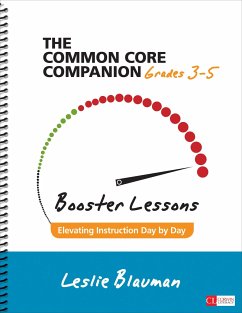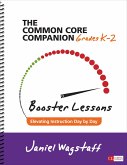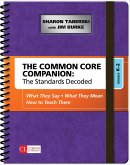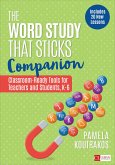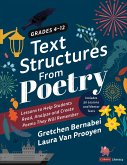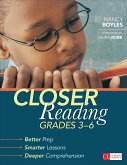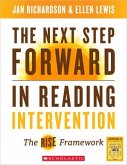Leslie A Blauman
The Common Core Companion: Booster Lessons, Grades 3-5
Elevating Instruction Day by Day
Leslie A Blauman
The Common Core Companion: Booster Lessons, Grades 3-5
Elevating Instruction Day by Day
- Broschiertes Buch
- Merkliste
- Auf die Merkliste
- Bewerten Bewerten
- Teilen
- Produkt teilen
- Produkterinnerung
- Produkterinnerung
In this follow-up to her Common Core Companion, Grades 3-5, Leslie Blauman provides an ample supply of connected lessons you can use as booster shots when students need a good dose of integrated reading and writing instruction. The 50+ lessons are divided into five learning sequences that span the ELA standards, bringing a Monday-through-Friday clarity to a process that often overwhelms teachers and coaches alike.
Andere Kunden interessierten sich auch für
![The Common Core Companion: Booster Lessons, Grades K-2 The Common Core Companion: Booster Lessons, Grades K-2]() Janiel M GuntherThe Common Core Companion: Booster Lessons, Grades K-242,99 €
Janiel M GuntherThe Common Core Companion: Booster Lessons, Grades K-242,99 €![The Common Core Companion: The Standards Decoded, Grades K-2 The Common Core Companion: The Standards Decoded, Grades K-2]() Sharon D TaberskiThe Common Core Companion: The Standards Decoded, Grades K-242,99 €
Sharon D TaberskiThe Common Core Companion: The Standards Decoded, Grades K-242,99 €![The Word Study That Sticks Companion The Word Study That Sticks Companion]() Pamela A KoutrakosThe Word Study That Sticks Companion41,99 €
Pamela A KoutrakosThe Word Study That Sticks Companion41,99 €![Text Structures from Poetry, Grades 4-12 Text Structures from Poetry, Grades 4-12]() Gretchen BernabeiText Structures from Poetry, Grades 4-1241,99 €
Gretchen BernabeiText Structures from Poetry, Grades 4-1241,99 €![Closer Reading, Grades 3-6 Closer Reading, Grades 3-6]() Nancy N BoylesCloser Reading, Grades 3-636,99 €
Nancy N BoylesCloser Reading, Grades 3-636,99 €![Teaching English Language and Literature 16-19 Teaching English Language and Literature 16-19]() Teaching English Language and Literature 16-19191,99 €
Teaching English Language and Literature 16-19191,99 €![The Next Step Forward in Reading Intervention The Next Step Forward in Reading Intervention]() Jan RichardsonThe Next Step Forward in Reading Intervention29,99 €
Jan RichardsonThe Next Step Forward in Reading Intervention29,99 €-
-
-
In this follow-up to her Common Core Companion, Grades 3-5, Leslie Blauman provides an ample supply of connected lessons you can use as booster shots when students need a good dose of integrated reading and writing instruction. The 50+ lessons are divided into five learning sequences that span the ELA standards, bringing a Monday-through-Friday clarity to a process that often overwhelms teachers and coaches alike.
Hinweis: Dieser Artikel kann nur an eine deutsche Lieferadresse ausgeliefert werden.
Hinweis: Dieser Artikel kann nur an eine deutsche Lieferadresse ausgeliefert werden.
Produktdetails
- Produktdetails
- Verlag: Sage Publications
- Seitenzahl: 280
- Erscheinungstermin: 28. Juli 2015
- Englisch
- Abmessung: 274mm x 216mm x 23mm
- Gewicht: 794g
- ISBN-13: 9781483392745
- ISBN-10: 1483392740
- Artikelnr.: 42205673
- Verlag: Sage Publications
- Seitenzahl: 280
- Erscheinungstermin: 28. Juli 2015
- Englisch
- Abmessung: 274mm x 216mm x 23mm
- Gewicht: 794g
- ISBN-13: 9781483392745
- ISBN-10: 1483392740
- Artikelnr.: 42205673
Leslie Blauman has been teaching reading and literacy in the Colorado public schools for over 30 years. Leslie's classroom is a working model for child/staff development in reading, writing, and critical thinking. Partnering with the Denver-based Public Education and Business Coalition (PEBC), her classroom is frequently the subject of professional workshops, classroom reading enhancement films, and education journals. While she works with teachers and students in a majority of the states and internationally as a consultant, her heart is in the classroom and she brings this to both her writing and her consulting. She speaks regularly at teacher/literacy conferences and workshops.
Introduction
LESSON SEQUENCE 1: Integrating Opinion Writing With Evaluating Argument
What Teachers Guide Across the Week
What Students Do Across the Week
Booster Reading Lesson 1: Understanding Point of View
Adapting This Lesson for Other Text Types: Informational
Companion Writing Lesson 1: Launching Opinion and Persuasive Writing
Snapshot of a Turn-and-Talk Peer Conference on POV
Booster Reading Lesson 2: Co-Constructing and Close Reading
Companion Writing Lesson 2: Determine Structure and Essential Elements
Language Connections: Formal Versus Informal English
Booster Reading Lesson 3: Reading and Annotating Fairy Tales
Companion Writing Lesson 3: Planning and Drafting
Booster Reading Lesson 4: Compare/Contrast Writing
Companion Writing Lesson 4: Revision Focus on Transition Words
Booster Reading Lesson 5: Complete Compare/Contrast Piece
Companion Writing Lesson 5: Edit and Finalize Piece
Third-Grade Adaptation
Fifth-Grade Adaptation
NEXT INSTRUCTIONAL STEPS
What Do I See? A Student Sample of Persuasive Writing
What Do I See? A Student Sample of Compare and Contrast
Authentic Assessment: Student Reflection and Evaluation
Peer Power: How to Use Student Work as Mentor Texts
If/Then Chart
Mentor Texts
Unit Planning: How to Build Out Three Weeks
LESSON SEQUENCE 2: Integrating Reading Craft and Structure With Opinion
Writing
What Teachers Guide Across the Week
What Students Do Across the Week
Booster Reading Lesson 1: Explaining How an Author Uses Reasons and
Evidence in Informational Text
Companion Writing Lesson 1: Expressing an Opinion in Response to Text
Booster Reading Lesson 2: Examining How Text Features Help With Main Idea
and Evidence
Companion Writing Lesson 2: Modeling Opinion Writing
Language Connections: Determine or Clarify the Meaning of Unknown Words
Booster Reading Lesson 3: Using Essential Questions to Dig Deeper
Companion Writing Lesson 3: Launching Opinion Writing
Booster Reading Lesson 4: Moving to Independence
Companion Writing Lesson 4: Working Through the Writing Process
Booster Reading Lesson 5: Assessing Our Learning
Companion Writing Lesson 5: Wrapping Up the Writing
Snapshot of How to Move From a Written Opinion Piece to a Speech
Third-Grade Adaptation
Fourth-Grade Adaptation
NEXT INSTRUCTIONAL STEPS
What Do I See? A Student Sample of Response to Reading
What Do I See? A Student Sample of Response to Reading
Authentic Assessment: Student Reflection and Evaluation
Peer Power: How to Use Student Work as Mentor Texts
If/Then Chart
Mentor Texts
Unit Planning: How to Build Out Three Weeks
LESSON SEQUENCE 3: Integrating Narrative Writing With Craft and Structure
What Teachers Guide Across the Week
What Students Do Across the Week
Booster Reading Lesson 1: Elements of Myths
Companion Writing Lesson 1: Starting to Envision an Original Myth
Adapting This Lesson for Other Text Types: Informational
Booster Reading Lesson 2: Co-Constructing a Summary and Independent Reading
Companion Writing Lesson 2: Planning a Myth
Booster Reading Lesson 3: Mini-Book Clubs
Companion Writing Lesson 3: Adding Character Description and Dialogue
Language Connections: Eavesdropping on a Book Club Conversation
Booster Reading Lesson 4: Looking at Language
Companion Writing Lesson 4: Rich Language Equals Rich Writing
Booster Reading Lesson 5: Wrapping Up and Assessment
Companion Writing Lesson 5: Finalizing the Myths
Langage Connections: Reading With Fluency
Third-Grade Adaptation
Fifth-Grade Adaptation
NEXT INSTRUCTIONAL STEPS
What Do I See? A Student Response to Literary Elements
What Do I See? A Student Sample of an Original Myth
Authentic Assessment: Student Reflection and Evaluation
Peer Power: How to Use Student Work as Mentor Texts
If/Then Chart
Mentor Texts
Unit Planning: How to Build Out Three Weeks
LESSON SEQUENCE 4: Integrating Explanatory Text Writing With Reading for
Key Ideas
What Teachers Guide Across the Week
What Students Do Across the Week
Booster Writing Lesson 1: Informative/Explanatory Text Makes the World Go
¿Round
Companion Reading Lesson 1: Noticing Text Features
Adapting This Lesson for Other Text Types: Literature
Booster Writing Lesson 2: Grouping by Headings
Companion Reading Lesson 2: How Authors Use Headings
Booster Writing Lesson 3: Sequencing Information
Companion Reading Lesson 3: Close Reading a Text and Visuals
Language Connections: Vocabulary
Booster Writing Lesson 4: Vocabulary and Elaboration
Companion Reading Lesson 4: Assessing Understanding With Annotating and
Summarizing Text
Booster Writing Lesson 5: Presenting the "All About" Pieces
Companion Reading Lesson 5: Presenting the "All About" Pieces
Snapshot of a Presentation
Fourth-Grade Adaptation
Fifth-Grade Adaptation
NEXT INSTRUCTIONAL STEPS
What Do I See? A Student Sample of Informative Text
What Do I See? A Student Sample of a Topic Written in Two Different Formats
Authentic Assessment: Student Reflection and Evaluation
Peer Power: How to Use Student Work as Mentor Texts
If/Then Chart
Mentor Texts
Unit Planning: How to Build Out Three Weeks
LESSON SEQUENCE 5: Integrating Research With Presentation
What Teachers Guide Across the Week
What Students Do Across the Week
Booster Writing Lesson 1: Introducing Research and Questions
Companion Reading Lesson 1: Evaluating Print and Digital Content
Adapting This Lesson for Other Text Types: Literature
Booster Writing Lesson 2: Determining Importance and Note-Taking
Companion Reading Lesson 2: Becoming a Media-Savvy, Critical Reader
Snapshot of Student Collaboration
Language Connections: Words in Their Best Order
Booster Writing Lesson 3: A Focus on Note-Taking
Companion Reading Lesson 3: Analyzing Notes
Booster Writing Lesson 4: Drafting
Companion Reading Lesson 4: Re-Reading and Refining Drafts
Booster Writing Lesson 5: Putting It All Together
Companion Reading Lesson 5: Compelling Conclusions
Third-Grade Adaptation
Fourth-Grade Adaptation
NEXT INSTRUCTIONAL STEPS
What Do I See? A Student Sample of a Nonfiction Article
What Do I See? A Student Sample of a Nonfiction Research Piece
Authentic Assessment: Student Reflection and Evaluation
Peer Power: How to Use Student Work as Mentor Texts
If/Then Chart
Mentor Texts
Unit Planning: How to Build Out Three Weeks
References
LESSON SEQUENCE 1: Integrating Opinion Writing With Evaluating Argument
What Teachers Guide Across the Week
What Students Do Across the Week
Booster Reading Lesson 1: Understanding Point of View
Adapting This Lesson for Other Text Types: Informational
Companion Writing Lesson 1: Launching Opinion and Persuasive Writing
Snapshot of a Turn-and-Talk Peer Conference on POV
Booster Reading Lesson 2: Co-Constructing and Close Reading
Companion Writing Lesson 2: Determine Structure and Essential Elements
Language Connections: Formal Versus Informal English
Booster Reading Lesson 3: Reading and Annotating Fairy Tales
Companion Writing Lesson 3: Planning and Drafting
Booster Reading Lesson 4: Compare/Contrast Writing
Companion Writing Lesson 4: Revision Focus on Transition Words
Booster Reading Lesson 5: Complete Compare/Contrast Piece
Companion Writing Lesson 5: Edit and Finalize Piece
Third-Grade Adaptation
Fifth-Grade Adaptation
NEXT INSTRUCTIONAL STEPS
What Do I See? A Student Sample of Persuasive Writing
What Do I See? A Student Sample of Compare and Contrast
Authentic Assessment: Student Reflection and Evaluation
Peer Power: How to Use Student Work as Mentor Texts
If/Then Chart
Mentor Texts
Unit Planning: How to Build Out Three Weeks
LESSON SEQUENCE 2: Integrating Reading Craft and Structure With Opinion
Writing
What Teachers Guide Across the Week
What Students Do Across the Week
Booster Reading Lesson 1: Explaining How an Author Uses Reasons and
Evidence in Informational Text
Companion Writing Lesson 1: Expressing an Opinion in Response to Text
Booster Reading Lesson 2: Examining How Text Features Help With Main Idea
and Evidence
Companion Writing Lesson 2: Modeling Opinion Writing
Language Connections: Determine or Clarify the Meaning of Unknown Words
Booster Reading Lesson 3: Using Essential Questions to Dig Deeper
Companion Writing Lesson 3: Launching Opinion Writing
Booster Reading Lesson 4: Moving to Independence
Companion Writing Lesson 4: Working Through the Writing Process
Booster Reading Lesson 5: Assessing Our Learning
Companion Writing Lesson 5: Wrapping Up the Writing
Snapshot of How to Move From a Written Opinion Piece to a Speech
Third-Grade Adaptation
Fourth-Grade Adaptation
NEXT INSTRUCTIONAL STEPS
What Do I See? A Student Sample of Response to Reading
What Do I See? A Student Sample of Response to Reading
Authentic Assessment: Student Reflection and Evaluation
Peer Power: How to Use Student Work as Mentor Texts
If/Then Chart
Mentor Texts
Unit Planning: How to Build Out Three Weeks
LESSON SEQUENCE 3: Integrating Narrative Writing With Craft and Structure
What Teachers Guide Across the Week
What Students Do Across the Week
Booster Reading Lesson 1: Elements of Myths
Companion Writing Lesson 1: Starting to Envision an Original Myth
Adapting This Lesson for Other Text Types: Informational
Booster Reading Lesson 2: Co-Constructing a Summary and Independent Reading
Companion Writing Lesson 2: Planning a Myth
Booster Reading Lesson 3: Mini-Book Clubs
Companion Writing Lesson 3: Adding Character Description and Dialogue
Language Connections: Eavesdropping on a Book Club Conversation
Booster Reading Lesson 4: Looking at Language
Companion Writing Lesson 4: Rich Language Equals Rich Writing
Booster Reading Lesson 5: Wrapping Up and Assessment
Companion Writing Lesson 5: Finalizing the Myths
Langage Connections: Reading With Fluency
Third-Grade Adaptation
Fifth-Grade Adaptation
NEXT INSTRUCTIONAL STEPS
What Do I See? A Student Response to Literary Elements
What Do I See? A Student Sample of an Original Myth
Authentic Assessment: Student Reflection and Evaluation
Peer Power: How to Use Student Work as Mentor Texts
If/Then Chart
Mentor Texts
Unit Planning: How to Build Out Three Weeks
LESSON SEQUENCE 4: Integrating Explanatory Text Writing With Reading for
Key Ideas
What Teachers Guide Across the Week
What Students Do Across the Week
Booster Writing Lesson 1: Informative/Explanatory Text Makes the World Go
¿Round
Companion Reading Lesson 1: Noticing Text Features
Adapting This Lesson for Other Text Types: Literature
Booster Writing Lesson 2: Grouping by Headings
Companion Reading Lesson 2: How Authors Use Headings
Booster Writing Lesson 3: Sequencing Information
Companion Reading Lesson 3: Close Reading a Text and Visuals
Language Connections: Vocabulary
Booster Writing Lesson 4: Vocabulary and Elaboration
Companion Reading Lesson 4: Assessing Understanding With Annotating and
Summarizing Text
Booster Writing Lesson 5: Presenting the "All About" Pieces
Companion Reading Lesson 5: Presenting the "All About" Pieces
Snapshot of a Presentation
Fourth-Grade Adaptation
Fifth-Grade Adaptation
NEXT INSTRUCTIONAL STEPS
What Do I See? A Student Sample of Informative Text
What Do I See? A Student Sample of a Topic Written in Two Different Formats
Authentic Assessment: Student Reflection and Evaluation
Peer Power: How to Use Student Work as Mentor Texts
If/Then Chart
Mentor Texts
Unit Planning: How to Build Out Three Weeks
LESSON SEQUENCE 5: Integrating Research With Presentation
What Teachers Guide Across the Week
What Students Do Across the Week
Booster Writing Lesson 1: Introducing Research and Questions
Companion Reading Lesson 1: Evaluating Print and Digital Content
Adapting This Lesson for Other Text Types: Literature
Booster Writing Lesson 2: Determining Importance and Note-Taking
Companion Reading Lesson 2: Becoming a Media-Savvy, Critical Reader
Snapshot of Student Collaboration
Language Connections: Words in Their Best Order
Booster Writing Lesson 3: A Focus on Note-Taking
Companion Reading Lesson 3: Analyzing Notes
Booster Writing Lesson 4: Drafting
Companion Reading Lesson 4: Re-Reading and Refining Drafts
Booster Writing Lesson 5: Putting It All Together
Companion Reading Lesson 5: Compelling Conclusions
Third-Grade Adaptation
Fourth-Grade Adaptation
NEXT INSTRUCTIONAL STEPS
What Do I See? A Student Sample of a Nonfiction Article
What Do I See? A Student Sample of a Nonfiction Research Piece
Authentic Assessment: Student Reflection and Evaluation
Peer Power: How to Use Student Work as Mentor Texts
If/Then Chart
Mentor Texts
Unit Planning: How to Build Out Three Weeks
References
Introduction
LESSON SEQUENCE 1: Integrating Opinion Writing With Evaluating Argument
What Teachers Guide Across the Week
What Students Do Across the Week
Booster Reading Lesson 1: Understanding Point of View
Adapting This Lesson for Other Text Types: Informational
Companion Writing Lesson 1: Launching Opinion and Persuasive Writing
Snapshot of a Turn-and-Talk Peer Conference on POV
Booster Reading Lesson 2: Co-Constructing and Close Reading
Companion Writing Lesson 2: Determine Structure and Essential Elements
Language Connections: Formal Versus Informal English
Booster Reading Lesson 3: Reading and Annotating Fairy Tales
Companion Writing Lesson 3: Planning and Drafting
Booster Reading Lesson 4: Compare/Contrast Writing
Companion Writing Lesson 4: Revision Focus on Transition Words
Booster Reading Lesson 5: Complete Compare/Contrast Piece
Companion Writing Lesson 5: Edit and Finalize Piece
Third-Grade Adaptation
Fifth-Grade Adaptation
NEXT INSTRUCTIONAL STEPS
What Do I See? A Student Sample of Persuasive Writing
What Do I See? A Student Sample of Compare and Contrast
Authentic Assessment: Student Reflection and Evaluation
Peer Power: How to Use Student Work as Mentor Texts
If/Then Chart
Mentor Texts
Unit Planning: How to Build Out Three Weeks
LESSON SEQUENCE 2: Integrating Reading Craft and Structure With Opinion
Writing
What Teachers Guide Across the Week
What Students Do Across the Week
Booster Reading Lesson 1: Explaining How an Author Uses Reasons and
Evidence in Informational Text
Companion Writing Lesson 1: Expressing an Opinion in Response to Text
Booster Reading Lesson 2: Examining How Text Features Help With Main Idea
and Evidence
Companion Writing Lesson 2: Modeling Opinion Writing
Language Connections: Determine or Clarify the Meaning of Unknown Words
Booster Reading Lesson 3: Using Essential Questions to Dig Deeper
Companion Writing Lesson 3: Launching Opinion Writing
Booster Reading Lesson 4: Moving to Independence
Companion Writing Lesson 4: Working Through the Writing Process
Booster Reading Lesson 5: Assessing Our Learning
Companion Writing Lesson 5: Wrapping Up the Writing
Snapshot of How to Move From a Written Opinion Piece to a Speech
Third-Grade Adaptation
Fourth-Grade Adaptation
NEXT INSTRUCTIONAL STEPS
What Do I See? A Student Sample of Response to Reading
What Do I See? A Student Sample of Response to Reading
Authentic Assessment: Student Reflection and Evaluation
Peer Power: How to Use Student Work as Mentor Texts
If/Then Chart
Mentor Texts
Unit Planning: How to Build Out Three Weeks
LESSON SEQUENCE 3: Integrating Narrative Writing With Craft and Structure
What Teachers Guide Across the Week
What Students Do Across the Week
Booster Reading Lesson 1: Elements of Myths
Companion Writing Lesson 1: Starting to Envision an Original Myth
Adapting This Lesson for Other Text Types: Informational
Booster Reading Lesson 2: Co-Constructing a Summary and Independent Reading
Companion Writing Lesson 2: Planning a Myth
Booster Reading Lesson 3: Mini-Book Clubs
Companion Writing Lesson 3: Adding Character Description and Dialogue
Language Connections: Eavesdropping on a Book Club Conversation
Booster Reading Lesson 4: Looking at Language
Companion Writing Lesson 4: Rich Language Equals Rich Writing
Booster Reading Lesson 5: Wrapping Up and Assessment
Companion Writing Lesson 5: Finalizing the Myths
Langage Connections: Reading With Fluency
Third-Grade Adaptation
Fifth-Grade Adaptation
NEXT INSTRUCTIONAL STEPS
What Do I See? A Student Response to Literary Elements
What Do I See? A Student Sample of an Original Myth
Authentic Assessment: Student Reflection and Evaluation
Peer Power: How to Use Student Work as Mentor Texts
If/Then Chart
Mentor Texts
Unit Planning: How to Build Out Three Weeks
LESSON SEQUENCE 4: Integrating Explanatory Text Writing With Reading for
Key Ideas
What Teachers Guide Across the Week
What Students Do Across the Week
Booster Writing Lesson 1: Informative/Explanatory Text Makes the World Go
¿Round
Companion Reading Lesson 1: Noticing Text Features
Adapting This Lesson for Other Text Types: Literature
Booster Writing Lesson 2: Grouping by Headings
Companion Reading Lesson 2: How Authors Use Headings
Booster Writing Lesson 3: Sequencing Information
Companion Reading Lesson 3: Close Reading a Text and Visuals
Language Connections: Vocabulary
Booster Writing Lesson 4: Vocabulary and Elaboration
Companion Reading Lesson 4: Assessing Understanding With Annotating and
Summarizing Text
Booster Writing Lesson 5: Presenting the "All About" Pieces
Companion Reading Lesson 5: Presenting the "All About" Pieces
Snapshot of a Presentation
Fourth-Grade Adaptation
Fifth-Grade Adaptation
NEXT INSTRUCTIONAL STEPS
What Do I See? A Student Sample of Informative Text
What Do I See? A Student Sample of a Topic Written in Two Different Formats
Authentic Assessment: Student Reflection and Evaluation
Peer Power: How to Use Student Work as Mentor Texts
If/Then Chart
Mentor Texts
Unit Planning: How to Build Out Three Weeks
LESSON SEQUENCE 5: Integrating Research With Presentation
What Teachers Guide Across the Week
What Students Do Across the Week
Booster Writing Lesson 1: Introducing Research and Questions
Companion Reading Lesson 1: Evaluating Print and Digital Content
Adapting This Lesson for Other Text Types: Literature
Booster Writing Lesson 2: Determining Importance and Note-Taking
Companion Reading Lesson 2: Becoming a Media-Savvy, Critical Reader
Snapshot of Student Collaboration
Language Connections: Words in Their Best Order
Booster Writing Lesson 3: A Focus on Note-Taking
Companion Reading Lesson 3: Analyzing Notes
Booster Writing Lesson 4: Drafting
Companion Reading Lesson 4: Re-Reading and Refining Drafts
Booster Writing Lesson 5: Putting It All Together
Companion Reading Lesson 5: Compelling Conclusions
Third-Grade Adaptation
Fourth-Grade Adaptation
NEXT INSTRUCTIONAL STEPS
What Do I See? A Student Sample of a Nonfiction Article
What Do I See? A Student Sample of a Nonfiction Research Piece
Authentic Assessment: Student Reflection and Evaluation
Peer Power: How to Use Student Work as Mentor Texts
If/Then Chart
Mentor Texts
Unit Planning: How to Build Out Three Weeks
References
LESSON SEQUENCE 1: Integrating Opinion Writing With Evaluating Argument
What Teachers Guide Across the Week
What Students Do Across the Week
Booster Reading Lesson 1: Understanding Point of View
Adapting This Lesson for Other Text Types: Informational
Companion Writing Lesson 1: Launching Opinion and Persuasive Writing
Snapshot of a Turn-and-Talk Peer Conference on POV
Booster Reading Lesson 2: Co-Constructing and Close Reading
Companion Writing Lesson 2: Determine Structure and Essential Elements
Language Connections: Formal Versus Informal English
Booster Reading Lesson 3: Reading and Annotating Fairy Tales
Companion Writing Lesson 3: Planning and Drafting
Booster Reading Lesson 4: Compare/Contrast Writing
Companion Writing Lesson 4: Revision Focus on Transition Words
Booster Reading Lesson 5: Complete Compare/Contrast Piece
Companion Writing Lesson 5: Edit and Finalize Piece
Third-Grade Adaptation
Fifth-Grade Adaptation
NEXT INSTRUCTIONAL STEPS
What Do I See? A Student Sample of Persuasive Writing
What Do I See? A Student Sample of Compare and Contrast
Authentic Assessment: Student Reflection and Evaluation
Peer Power: How to Use Student Work as Mentor Texts
If/Then Chart
Mentor Texts
Unit Planning: How to Build Out Three Weeks
LESSON SEQUENCE 2: Integrating Reading Craft and Structure With Opinion
Writing
What Teachers Guide Across the Week
What Students Do Across the Week
Booster Reading Lesson 1: Explaining How an Author Uses Reasons and
Evidence in Informational Text
Companion Writing Lesson 1: Expressing an Opinion in Response to Text
Booster Reading Lesson 2: Examining How Text Features Help With Main Idea
and Evidence
Companion Writing Lesson 2: Modeling Opinion Writing
Language Connections: Determine or Clarify the Meaning of Unknown Words
Booster Reading Lesson 3: Using Essential Questions to Dig Deeper
Companion Writing Lesson 3: Launching Opinion Writing
Booster Reading Lesson 4: Moving to Independence
Companion Writing Lesson 4: Working Through the Writing Process
Booster Reading Lesson 5: Assessing Our Learning
Companion Writing Lesson 5: Wrapping Up the Writing
Snapshot of How to Move From a Written Opinion Piece to a Speech
Third-Grade Adaptation
Fourth-Grade Adaptation
NEXT INSTRUCTIONAL STEPS
What Do I See? A Student Sample of Response to Reading
What Do I See? A Student Sample of Response to Reading
Authentic Assessment: Student Reflection and Evaluation
Peer Power: How to Use Student Work as Mentor Texts
If/Then Chart
Mentor Texts
Unit Planning: How to Build Out Three Weeks
LESSON SEQUENCE 3: Integrating Narrative Writing With Craft and Structure
What Teachers Guide Across the Week
What Students Do Across the Week
Booster Reading Lesson 1: Elements of Myths
Companion Writing Lesson 1: Starting to Envision an Original Myth
Adapting This Lesson for Other Text Types: Informational
Booster Reading Lesson 2: Co-Constructing a Summary and Independent Reading
Companion Writing Lesson 2: Planning a Myth
Booster Reading Lesson 3: Mini-Book Clubs
Companion Writing Lesson 3: Adding Character Description and Dialogue
Language Connections: Eavesdropping on a Book Club Conversation
Booster Reading Lesson 4: Looking at Language
Companion Writing Lesson 4: Rich Language Equals Rich Writing
Booster Reading Lesson 5: Wrapping Up and Assessment
Companion Writing Lesson 5: Finalizing the Myths
Langage Connections: Reading With Fluency
Third-Grade Adaptation
Fifth-Grade Adaptation
NEXT INSTRUCTIONAL STEPS
What Do I See? A Student Response to Literary Elements
What Do I See? A Student Sample of an Original Myth
Authentic Assessment: Student Reflection and Evaluation
Peer Power: How to Use Student Work as Mentor Texts
If/Then Chart
Mentor Texts
Unit Planning: How to Build Out Three Weeks
LESSON SEQUENCE 4: Integrating Explanatory Text Writing With Reading for
Key Ideas
What Teachers Guide Across the Week
What Students Do Across the Week
Booster Writing Lesson 1: Informative/Explanatory Text Makes the World Go
¿Round
Companion Reading Lesson 1: Noticing Text Features
Adapting This Lesson for Other Text Types: Literature
Booster Writing Lesson 2: Grouping by Headings
Companion Reading Lesson 2: How Authors Use Headings
Booster Writing Lesson 3: Sequencing Information
Companion Reading Lesson 3: Close Reading a Text and Visuals
Language Connections: Vocabulary
Booster Writing Lesson 4: Vocabulary and Elaboration
Companion Reading Lesson 4: Assessing Understanding With Annotating and
Summarizing Text
Booster Writing Lesson 5: Presenting the "All About" Pieces
Companion Reading Lesson 5: Presenting the "All About" Pieces
Snapshot of a Presentation
Fourth-Grade Adaptation
Fifth-Grade Adaptation
NEXT INSTRUCTIONAL STEPS
What Do I See? A Student Sample of Informative Text
What Do I See? A Student Sample of a Topic Written in Two Different Formats
Authentic Assessment: Student Reflection and Evaluation
Peer Power: How to Use Student Work as Mentor Texts
If/Then Chart
Mentor Texts
Unit Planning: How to Build Out Three Weeks
LESSON SEQUENCE 5: Integrating Research With Presentation
What Teachers Guide Across the Week
What Students Do Across the Week
Booster Writing Lesson 1: Introducing Research and Questions
Companion Reading Lesson 1: Evaluating Print and Digital Content
Adapting This Lesson for Other Text Types: Literature
Booster Writing Lesson 2: Determining Importance and Note-Taking
Companion Reading Lesson 2: Becoming a Media-Savvy, Critical Reader
Snapshot of Student Collaboration
Language Connections: Words in Their Best Order
Booster Writing Lesson 3: A Focus on Note-Taking
Companion Reading Lesson 3: Analyzing Notes
Booster Writing Lesson 4: Drafting
Companion Reading Lesson 4: Re-Reading and Refining Drafts
Booster Writing Lesson 5: Putting It All Together
Companion Reading Lesson 5: Compelling Conclusions
Third-Grade Adaptation
Fourth-Grade Adaptation
NEXT INSTRUCTIONAL STEPS
What Do I See? A Student Sample of a Nonfiction Article
What Do I See? A Student Sample of a Nonfiction Research Piece
Authentic Assessment: Student Reflection and Evaluation
Peer Power: How to Use Student Work as Mentor Texts
If/Then Chart
Mentor Texts
Unit Planning: How to Build Out Three Weeks
References
